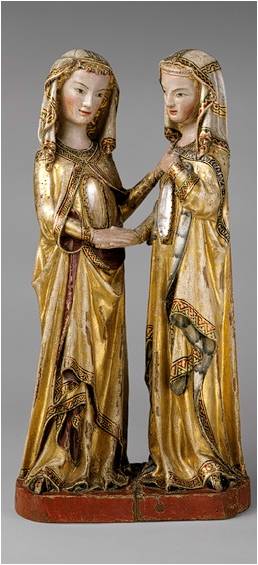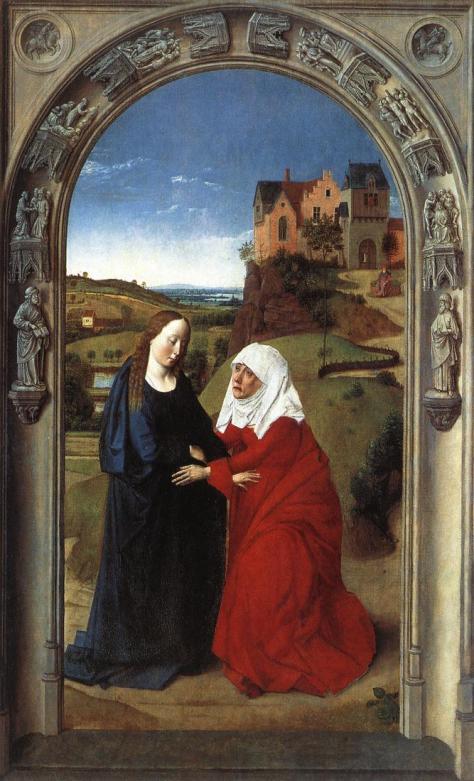In those days a decree went out from Caesar Augustus
that the whole world should be enrolled.
This was the first enrollment,
when Quirinius was governor of Syria.
So all went to be enrolled, each to his own town.
And Joseph too went up from Galilee from the town of Nazareth
to Judea, to the city of David that is called Bethlehem,
because he was of the house and family of David,
to be enrolled with Mary, his betrothed, who was with child.
While they were there,
the time came for her to have her child,
and she gave birth to her firstborn son.
She wrapped him in swaddling clothes and laid him in a manger,
because there was no room for them in the inn.
Now there were shepherds in that region living in the fields
and keeping the night watch over their flock.
The angel of the Lord appeared to them
and the glory of the Lord shone around them,
and they were struck with great fear.
The angel said to them,
“Do not be afraid;
for behold, I proclaim to you good news of great joy
that will be for all the people.
For today in the city of David
a savior has been born for you who is Christ and Lord.
And this will be a sign for you:
you will find an infant wrapped in swaddling clothes
and lying in a manger.”
And suddenly there was a multitude of the heavenly host with the angel,
praising God and saying:
“Glory to God in the highest
and on earth peace to those on whom his favor rests.”
Luke 2:1-14

Nativity, Giotto Di Bondone, 1305, Scrovegni (Arena) Chapel, Padua, Italy
The art of Giotto Di Bondone lies between the flat Byzantine medieval style and the revolutionary art of the Renaissance and he is often called the Father of Renaissance art. He boldly experimented with naturalism, modeling, and perspective; he painted blue skies instead of gold and used other color more freely; he included naturalistic scenery; and he used shading to indicate volume. Perhaps most importantly, Giotto often showed the intense emotions of the moment in the faces he painted.
Giotto painted a scene of the Nativity in the Scrovegni Chapel, also known as the Arena Chapel, in Padua, in a fresco cycle regarded as his masterpiece. The layout in this scene is similar to Byzantine icons of the nativity but the artist has given it his own charm. We see the Holy Family within a lean-to set against a rocky hillside, with Mary, lying on a makeshift bed on a rock ledge, being handed the swaddled infant Jesus by an attendant. We are immediately drawn to the gaze shared between Mary and Jesus, as they stare intently at each other. Joseph is often depicted as seen here, with his head on his hand as if weary from their long journey. An angel announces the birth to the shepherds at right, while more angels fly above, looking up to heaven with their hands held in praise.
Notice the flaking of the blue paint on Mary’s garment and the sky. The patron and owner of this chapel, Scrovegni, insisted that in some areas Giotto overpaint with blue to highlight the extravagance of the chapel, since the blue is a very costly pigment made of lapis lazuli. Unfortunately, though, the technique used, secco or dry fresco, rather than true fresco that bonds with the wet plaster, has led to the paint flaking away over time.
The ox and the ass shown at left are not included in the biblical text, but they are seen in our earliest depictions of the Nativity, such as this 4th century Roman sarcophagus from Milan.

Detail from the “Sarcofago di Stilicone” (“Stilicho’s sarcophagus”) ca 4th c., Sant’Ambrogio Basilica, Milan, Italy

Nativity, Giotto, 1311-20, fresco
San Francesco, Upper Church, Assisi, Italy
Giotto is thought by many scholars to have also painted the Nativity scene above for the fresco cycle in the church of Saint Francis in Assisi. We see three scenes side by side that are parts of a progressive narrative. The center foreground shows the newborn Jesus being swaddled after bathing while Joseph looks on from the left, weary or thoughtful. Mary lies on her makeshift bed holding the swaddled infant, upon whom golden beams of light come down from above. At the right, the angel announces the birth of the savior to shepherds, and we have the requisite animals in attendance. More angels above and below indicate that heaven has broken into the earthly realm to celebrate this miraculous event, the birth of God as man.
Though I was first inclined to attribute this work to Giotto, after studying it and comparing it with his Scrovegni Chapel paintings, I’ve come to agree with those who argue against a Giotto attribution. The figures lack the emotional intensity we see in the first Nativity scene; the angels are arrayed quite statically, with none of the lively variety of the other painting; the modeling and scenery seem rather flat. If this was actually painted by Giotto himself after the Arena Chapel, surely he would have developed and refined his technique even further. What do you think?
Regardless of artist, though, in both paintings there is that gaze between Mary and Jesus. In the Arena Chapel image, Mary is receiving her baby into her arms for the first time. How great must her awe have been, knowing that the mystery of God made flesh was there in her loving hands, held against her adoring breast!? Imagine the overwhelming love that swells in her heart as she sees him gazing back at her!
I invite you now to imagine yourself in this scene. Who are you?
- Are you Mary, staring adoringly at the Savior of the world, this tiny and helpless babe in your arms?
- Are you Joseph, weary and detached?
- Are you a shepherd, just hearing the Good News and trying to grasp what it means?
- Perhaps you’re an angel, proclaiming the Good News for all to hear!
- Or are you the baby, being held, nursed, and gazed upon with love by your mother Mary?
Choose one and sit with it for a few minutes. Let the experience penetrate deeply so that you can relate to Jesus in a meaningful and personal way. Allow your heart and mind to become immersed in the overwhelming mystery of the Incarnation.
Glory to God in the highest! May there be peace on earth and goodwill among men.
Merry Christmas.
















